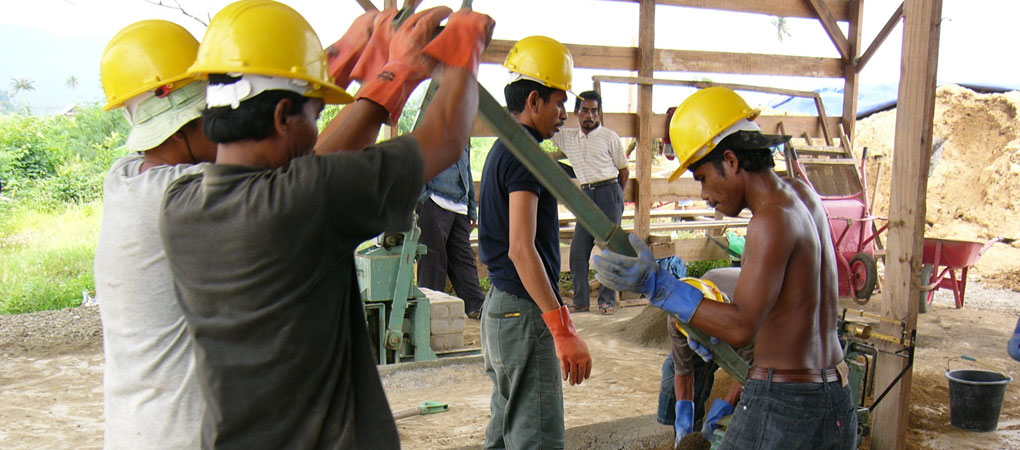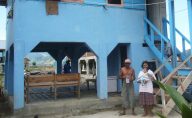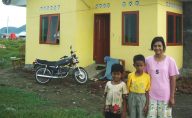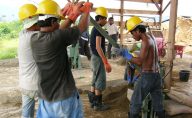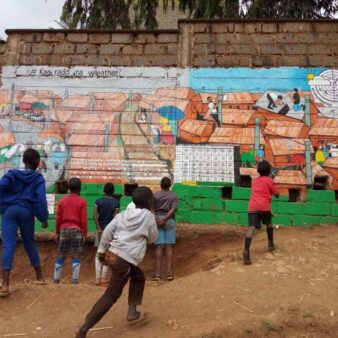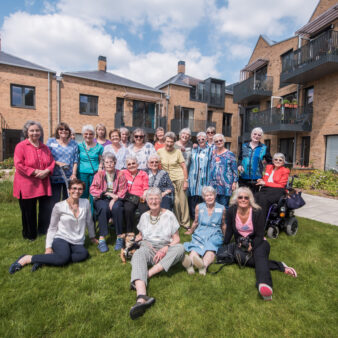Using a pro-poor approach, and in defiance of initial government relocation policy, Uplink is working with 23 of the villages worst affected by the 2004 tsunami to provide 3,500 homes and infrastructure and to increase community cohesion and reconciliation. Community members are involved at every level, and employed wherever possible. A combination of training and village based loan funds provides increased opportunities to improve long-term livelihood prospects.
Project Description
Aims and Objectives
The main purpose of the project is the reconstruction of Aceh community life following the devastating tsunami of December 2004. This includes:
- Reconstruction of houses and infrastructure
- Economic renewal
- Reinforcement of social relations and cultural cohesion
- Environmental regeneration.
Project context
The tsunami of December 2004 had a massive impact around the Indian Ocean’s rim, destroying lives, villages and livelihoods on a massive scale. This project is implemented in fishing communities along the west coast of Aceh Besar and Banda Aceh, which was one of the worst hit areas being located closest to the epicentre. There was virtually total devastation of all buildings and physical infrastructure in the area, as well as severe damage to the vibrant community life. Forty-seven per cent of the population in the 23 villages involved in this project died, reducing the population to 6,500.
Survivors in these villages began working with Urban Poor Linkage (UPLINK) immediately after the tsunami to rebuild their ruined settlements, physically, socially and economically. Uplink is an Indonesian coalition of grassroots and community based organisations and NGOs focussing on issues of urban poverty and impoverishment. It works to empower the urban poor through a combination of organisation, advocacy and networking.

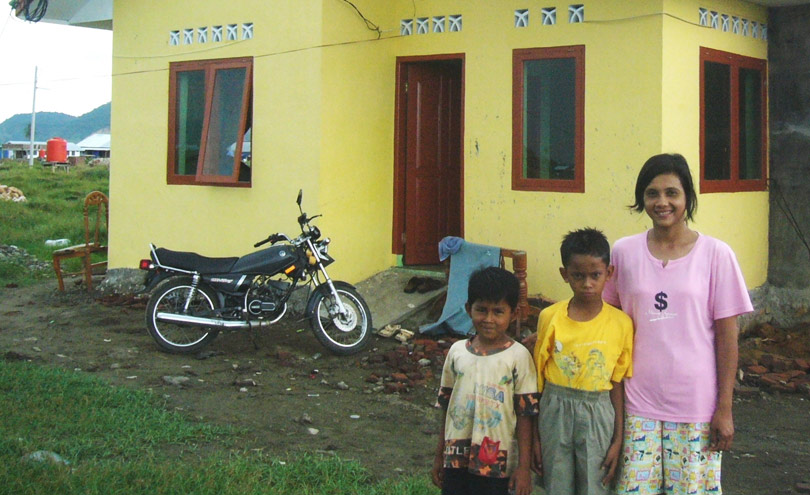
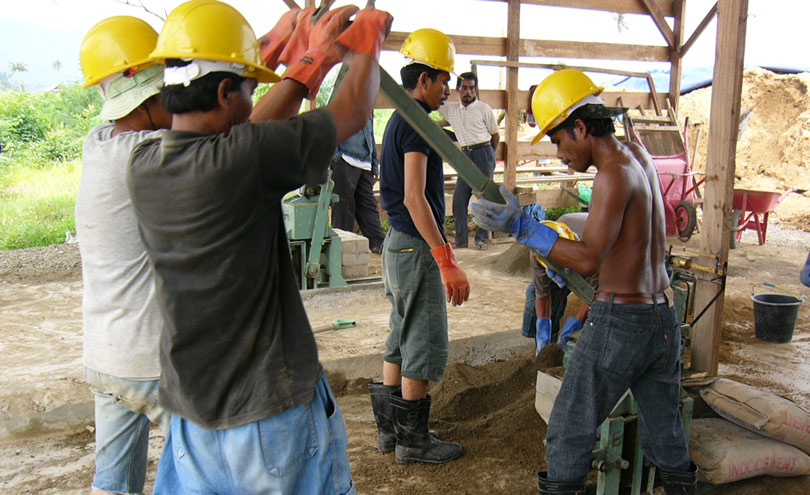
As well as the immediate threats to health and well-being, longer term reconstruction programmes faced additional challenges due to the difficulty in the identification and establishment of land ownership. The tsunami destroyed landmarks that had previously identified plot boundaries, as well as paper records certifying legal possession. Surviving families faced an increased struggle to retain the coastal land that they had previously inhabited due to its commercial value. In defiance of an initial government relocation policy, the people returned to the coast, proposing to make their communities safe by creating protective ecological barriers between sea and village. They established a network known as Jaringan Udeep Beusaree (JUB), meaning ‘live together’ in Acehnese, to provide strength and support for each other.
Key features
The integrated reconstruction approach seeks to ensure social, economic and cultural recovery as well as protection and preparedness for the future. Six hundred and forty temporary houses were built between February and May 2005, providing shelter until the 3,500 permanent homes and related infrastructure could be built. Every survivor who lost their home will own a permanent house, unless they have another house elsewhere that is undamaged. The houses are given free; there is no cost to repay. Three thousand of these homes are for surviving families and the other 500 are for members of the Free Aceh Movement (GAM), whose members are now returning to their villages after the signing of the peace agreement in Helsinki in August 2005. Uplink has ensured that the villagers’ struggle to go back to their land has received high levels of media coverage, identifying it as an example of a pro-poor reconstruction approach.
From the outset, the people’s participation and organisation have been key factors in successful community development. The members of the community have been involved in all aspects of the project. A complete survey was carried out of the ruined villages, including participatory land mapping and a full account of surviving families. Ownership certificates are being issued based on this work. Further involvement includes land surveying and mapping, housing design, material purchase and data collection; as well as playing crucial roles in the construction process as material suppliers, labourers, building inspectors and trainers. These opportunities have strengthened community members’ confidence, skills and expertise.
The project has a target that 60 per cent of the funds for reconstructing houses and infrastructure should stay in the village, so that the rebuilding process boosts the village economies. As well employing many community members within the construction process, building-block making plants have been established and have employed dozens of villagers. Only if the reconstruction labour and resource requirements cannot be met in the village itself are nearby villages approached.
A village-based revolving economic fund providing loan capital has been established to help village members, especially women’s groups, start small businesses. Training has been carried out as part of the project to extend the range of skills of the villagers and to give them greater opportunities to improve their livelihoods. Typical activities include acupuncture, block-making, composting, mushroom cultivation, disaster management, rice farming, earthquake-resistant construction and pedi-cab businesses. Seventy drivers have been given loans to buy their own pedi-cabs. Repayments are made into a collective fund, which can be drawn on for other economic activities and family emergencies.
Villagers are exploring ways of making their villages more ecologically healthy. Methods include using local building materials, recycling, carrying out organic wastewater treatment, and using renewable energy. Organic farming and the planting of special saline reducing plants is helping the soil return to good agricultural condition, following the salt contamination suffered by much of the land.
Natural barriers such as mangrove forests, cypress, coconut, banana, papaya and pine trees have been planted between the villages and the sea to act as buffer layers that will absorb the force of waves. Dikes and ditches will be added. It is recognised that these barriers would not be sufficient to protect against a similar tsunami but that education and pre-preparedness will be crucial to saving lives in the future. Well-signposted and wide escape routes are being prepared for each village to evacuation centres in the hills. These hills behind the villages are also being developed as productive agricultural assets, growing income-generating plants including chillies, vegetables and fruit trees. Fishponds are also being established
Covering costs
The project is one of reconstruction following a disaster and uses the donor aid provided in response to the event. There is no expectation that the communities can make a financial contribution but the project is time-limited and involves re-establishing opportunities for local people to earn a sustainable income.
Working together with Uplink’s technical team, several basic house designs were developed from which people could choose. The houses have been modestly built within the budget limit of US$4,200 per house, and at 36m2 are much smaller than the traditional large houses. They are designed to be enlarged incrementally as people’s means to do so increase. Infrastructure costs are US$1,300 per household and the remaining funds are used to provide community facilities, mosques, small-scale industries, trauma-healing sessions, eco-farming and training.
The programme has cost around US$45 million. MISEREOR Germany, Development and Peace Canada, CIDA Canada, and Plan International are the major project donors. There are also in-kind contributions from the beneficiaries who provide labour, local wisdom, participation and solidarity in the overall planning and implementation of the project.
Impact
The post-tsunami reconstruction process provided an opportunity to challenge many of the social inequalities that previously existed. The work carried out by Uplink has served to reinforce community solidarity and bring groups together. As well as a strengthening of overall community cohesion between the villages with the formation of JUB, previously marginalised women increasingly participate in village and inter-village activities and meetings.
The villagers who have been living in temporary shelters have now moved into their permanent houses. The impact has been great:
- A sense of security and stability has been restored to a traumatised community.
- Livelihoods have been restored.
- The sense of community cohesion has been strengthened in an area which had been torn apart with years of civil strife.
- There has been an increase of awareness among government, NGOs and other agencies working with such projects as to the importance of people’s participation in the reconstruction process.
Why is it innovative?
- Use of a people driven, holistic and integrated approach to disaster reconstruction. This is especially innovative, as many disaster reconstruction programmes are partial and physically oriented.
- Use of organising, advocacy, and networking as three intertwining strategies to address both physical and non-physical aspects of reconstruction.
- The approach is fast, cheap, transferable and comprehensive when compared to many other post-disaster reconstruction methods.
What is the environmental impact?
Local materials are used wherever possible, in order to meet the target of keeping 60 per cent of the recovery funds in the area, and to avoid paying the inflated prices of cement and blocks. Locally available materials include stone, sand, coconut wood and soil cement blocks. These are made by the villagers themselves.
The communities’ increased environmental awareness and understanding of their rights and responsibilities in respect of natural resources, has led to increased efforts in making their villages environmentally sustainable. Techniques that are being explored include the use of kitchen gardens, biogas and recycling materials and wastewater.
The full environmental impact of the project will take between two and five years to be felt. The salt contamination suffered by the soil has been addressed through the introduction of saline reducing plants and as the plants and trees continue to develop, the land will return to its original state.
Is it financially sustainable?
The programme cost of approximately US$ 45 million (which is US$ 12,850 per household) is time limited. It has provided the infrastructure to allow a second phase of the programme to begin involving strengthening the economy, raising political consciousness and increasing environmental awareness. The in-kind contributions of the local communities that provide labour, local wisdom, participation and solidarity in the overall planning and implementation of the project will continue. The houses are given free to facilitate the security and stability that owning a home brings. It is from this platform that communities can become financially sustainable following such massive devastation.
It is anticipated that future sources of revenue for JUB will be from small-scale industries that have been established. Block-making plants, for example, are employing dozens of villagers. It is anticipated that these will continue to operate for a considerable time and will have a long-term future. Other industries established include iron- and wood-work workshops and village-level organic farming.
Aiming to keep 60 per cent of the reconstruction funds within the village economies, has greatly enhanced the community members’ opportunities to gain employment, training and skills. The loan-capital available increases the long-term income generation prospects and has funded a rich diversity of small business start-ups.
What is the social impact?
The destruction to community life wrought by the tsunami undermined many of the social inequalities that had existed. The work carried out by Uplink has served to reinforce the communities and bring groups together.
The formation of JUB has strengthened community cohesion within and between the villages. Wider community participation has been encouraged and over 32 per cent of members cast their votes in the recent JUB general election. Trust has increased amongst community members who are now aware of the importance of solidarity and participation. Women now participate in community activities and meetings. Before the tsunami they were marginalised and their involvement not welcome. JUB is also involved in conflict resolution, construction quality control and organising of community activities.
A process of land consolidation is being planned in those villages where the land has disappeared. This involves the rearrangement of property rights in order to allow the layout and location of the village to be adjusted.
The ongoing livelihood training has increased the capabilities, self-belief and the range of skills that the villagers have, giving them greater income generation opportunities and the confidence to be increasingly involved in community life.
Barriers
- The large number of different stakeholders and their differing approaches and attitudes initially created tension, friction and even fragmentation within the communities. Uplink operates an open policy, being keen to work with any groups and organisations willing to co-ordinate and share.
- There has been no clear policy and control over building material prices. The unique context and influx of money has allowed prices to rise significantly. This may well result in budget problems. Appeals and demands to the government make very little difference. Materials are being shipped from further away where prices are lower.
Lessons Learned
- Post-disaster reconstruction is about more than physical facilities. It is about community and relationships.
- Having trust in the people’s resilience and wisdom is paramount and with a little support even the most traumatised people can immediately work together to begin to build a better life for themselves.
- Community participatory housing reconstruction can deliver a large number of well-constructed quality homes within a reasonable time frame.
Evaluation
As the funding for this work is coming from international donor agencies there has been a range of regular monitoring activities carried out. These include internal weekly monitoring sessions, monthly internal financial auditing, six-monthly external independent financial auditing, monthly reporting and three–monthly progress reporting.
Transfer
There have been a number of instances in which the approach used by Uplink in Aceh has been applied elsewhere:
- The Australian Red Cross is collaborating with Uplink to implement the same approach in Nasi Island, a small island off the Banda Aceh coast.
- Uplink’s reconstruction approach has been applied by the government Post-tsunami Reconstruction and Rehabilitation Agency (BRR) to its work.
- Uplink is implementing the same project in its post-earthquake reconstruction project in Yogyakarta.
- Other NGOs are transferring Uplink’s participatory approach to other housing projects in post-tsunami Aceh. These include: Local Governance & Infrastructure for Communities in Aceh, British Red Cross, Centre for Poverty Analysis, Atlas and Plan International.
Partnership
Local NGOs, international donors, donor agency, CBO, local community

